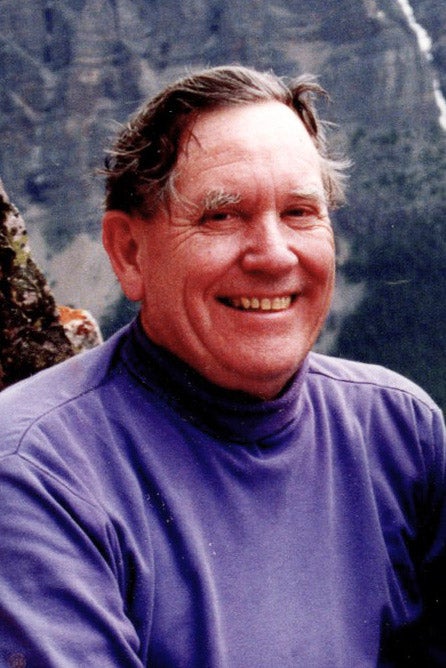H. Pierre Noyes, the first director of the SLAC National Accelerator Laboratory Theory Group, died in Stanford on Sept. 30, 2016, at age 92. Noyes, a theoretical physicist, leaves behind a legacy of distinctive academic work and activism.
“Noyes was widely known for his kindness, willingness to listen to others, and his egalitarianism,” said David McGoveran, Noyes’ friend and former colleague. “He will be missed by his associates, students and colleagues, as well as many others, all of whom came to know and love him and benefited from his generosity of spirit.”
Part of science history
Henry Pierre Noyes was born on December 10, 1923, in Paris, France. He graduated from Harvard University with a degree in physics in 1943. At Harvard Noyes roomed with Thomas Kuhn and later served as a reader for an early draft of the now-famous book, The Structure of Scientific Revolutions. After graduating, Noyes spent a year at the Massachusetts Institute of Technology’s Radiation Laboratory and two years in the U.S. Navy. In 1950, Noyes graduated from the University of California, Berkeley, with a doctorate in theoretical physics.
Among his varied activities in the next 12 years, Noyes was a Fulbright Scholar at the University of Birmingham in England and leader of the General Research Group at Lawrence Livermore National Laboratory, where he also co-chaired a design-review committee that looked back at the Christmas Island nuclear tests. Following an invitation from Freeman Dyson, Noyes also consulted on Project Orion at General Atomics, which investigated the possibilities of a spacecraft propelled by nuclear pulses.
Time at Stanford and SLAC
In 1962, Noyes became an associate professor at Stanford University and the first director of the Theory Group at SLAC. He became a full professor in 1967 and a professor emeritus in 2000. The bulk of his work was on the three-body problem, which attempts to solve for interactions that occur between three subatomic particles. In 1979, he won the Alexander von Humboldt U.S. Senior Scientist Award for this research.
Some of Noyes’ research falls outside mainstream thought in theoretical physicists. One example is bit string physics, a theory that he helped establish and which McGoveran described as “a finite, discrete computational model of physics that takes as fundamental observables the dimensionless coupling constants of physics.” Noyes was also among the first physicists to propose that antimatter experiences antigravity, a theory now being tested at CERN, the European Organization for Nuclear Research.
“Noyes was an excellent scientist and seeker of knowledge who wanted to understand how the universe worked,” said Louis Kauffman, professor of mathematics at the University of Illinois at Chicago and editor of a 2014 collection of essays that commemorated Noyes’ work. “He had a strong imagination for theoretical physics and cosmology but also looked at other aspects of science, such as molecular biology.”
The Alternative Natural Philosophy Association (ANPA), which Noyes cofounded at Cambridge University in 1979, is an embodiment of the multidisciplinary lens through which he saw the world. Noyes once described the main goal of this group as “examin[ing] ideas for new scientific models of the universe that combine what is known about quantum mechanics, molecular biology and consciousness more thoroughly than present models.” He was the president of the ANPA from 1979 to 1987 and, along with McGoveran, established ANPA West at Stanford in 1984. Noyes also founded the Light Hearted Philosophy Group at Stanford around 1980.
A passionate humanist
On Jan. 20, 1970, Noyes and others filed a lawsuit against then-President Richard Nixon challenging the legality of the Vietnam War. In addition, he refused defense funding, terminated all of his military security clearances and stopped sending preprints of his papers to organizations that took part in military research. The suit was dropped when Nixon resigned.
Noyes also spoke out against American military presence in Iran during the late 1970s, even visiting Tehran as an independent observer of the Iranian government’s trial of 11 political prisoners. He later called the proceedings a “fraud.”
His views were strong and he made them known. But Noyes was also an enthusiastic listener with a talent for motivating others to think more broadly.
“Noyes was unique,” said Enrique Zeiger, Noyes’ former doctoral student. “He consistently provided support and encouragement, stimulated me to always think of expanding the parameters of my work, and provided a continuously evolving statement of a personal balance between the academic and social responsibilities of a scientist.”
The Noyes love story
Noyes met his wife, Mary, at a Valentine’s Day dance in Berkeley in 1947. They were married for almost 69 years. Mary grew up in Berkeley, graduated from Stanford in 1948 and earned a master’s degree in art history, also from Stanford, in 1974. She was a therapist who specialized in working with people who had experienced abuse or other trauma. She died six weeks after her husband, at the age of 91.
“They had a fairy-tale romance and were deeply in love all their lives,” said McGoveran. “It was quite charming, and was inspiring to witness.”
Pierre and Mary Noyes are survived by their children: David, Alan and Katia Noyes; grandchildren: Brian Noyes and Beth Goder; and great-grandchildren: Lucy and Emma Goder. In lieu of flowers, donations may be sent to the Alzheimer’s Association. A memorial resolution on behalf of Noyes will be presented at the March 9 Faculty Senate meeting.

